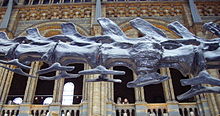Diplodocus
![]()
The title of this article is ambiguous. For the asteroid of the same name see (58671) Diplodocus.
Diplodocus ("double beam"; Ancient Greek διπλόος diplóos "double" and δοκός dokós "beam") is a genus of sauropod dinosaur from the Upper Jurassic (Kimmeridgian to Tithonian) of western North America.
The genus name refers to the V-shaped chevron bones on the underside of the caudal spine. Initially, the V-shaped appendages were thought to be an autapomorphy of Diplodocus, but they have been discovered in other diplodocids since the initial description.
Diplodocus was one of the more common genera of the Upper Morrison Formation, which is about 156 to 147 million years old, and belonged to a fauna dominated by giant sauropods such as Camarasaurus, Barosaurus, Apatosaurus, and Brachiosaurus. The dinosaur genus is one of the easiest to identify and for many years was considered the one with the largest body length. Its enormous size may have provided protection from predatory dinosaurs such as Allosaurus and Ceratosaurus.
Description
Diplodocus is one of the best known sauropods. The very large, quadrupedal animal possessed a long neck and a long, whip-like tail. The fact that the front legs were slightly shorter than the hind legs resulted in a horizontal posture, so that Diplodocus mechanically resembled a suspension bridge given its long neck, tail, and stocky legs. In fact, the longest complete dinosaur skeleton has been attributed to the genus Diplodocus. Some sauropods, such as Seismosaurus (whose skeletal remains may represent large representatives of the genus Diplodocus) and Supersaurus, probably reached even greater body lengths than Diplodocus, but have only fragmentary fossil records. Of the up to 27 m body length 6 meters were allotted to the neck. The skull was very small in relation to the body size. Diplodocus possessed small, pin-shaped teeth, which only filled the front part of the jaws and were directed obliquely forward from the root of the teeth. Its cranial capsule was small. The neck consisted of at least fifteen cervical vertebrae, and it is currently thought that the animal held it mostly parallel to the base and could barely lift it beyond that. Estimates of body weight vary, with recent studies giving 10, 11.5, 12.7, or 16 tons.
Diplodocus possessed an extremely long tail, consisting of about 80 caudal vertebrae, which was almost twice the number of caudal vertebrae of some early sauropods (such as Shunosaurus: 43) and far exceeded the representatives of Macronaria living at the same time (Camarasaurus: 53). There is speculation about the extent to which the tail had a direct defensive function or served as a (deterrent through) noise production.
The tail may also have served as a counterweight to the massive neck. The eponymous "double bars" of the chevron bones appear in the middle part of the tail as projections on the underside. They may have carried the weight of the tail or, in the case where the tail rested on the ground, protected the blood vessels from being crushed. In several related genera, "double beams" also occur.

caudal vertebra of the diplodocus

Skeleton diagram with humans as scale
Classification
Diplodocus is both the type genus and the namesake of the family Diplodocidae. Members of the family are considerably more slenderly built than titano- and brachiosaurs. They are characterized by long necks and tails and a horizontal posture. Their front legs are shorter than their hind legs. Diplodocids had their heyday in the Upper Jurassic. During this time they were common in North America and Africa. They were replaced during the Cretaceous by the titanosaurs, which occupied similar ecological niches.
The subfamily Diplodocinae includes Diplodocus and its closest relatives, including Seismosaurus, which may belong to the same genus, and Barosaurus. Apatosaurus, which appears in the fossil record at the same time, appears to be more distantly related to Diplodocus - the genus is included in the same family, but placed in the subfamily Apatosaurinae.
The Portuguese Dinheirosaurus and the African genus Tornieria have also been classified by some authors as close relatives of Diplodocus.
The superfamily Diplodocoidea includes the diplodocids as well as dicraeosaurids, rebbachisaurids, and the genus Suuwassea, Amphicoelias, and possibly Haplocanthosaurus, and/or the nemegtosaurids. This taxon forms the sister group to Camarasaurus, the brachiosaurids, and the titanosaurs (which are grouped together as Macronaria). Diplodocoidea and Macronaria together form the Neosauropoda, which is the largest, most diverse, and most successful group of sauropodomorph dinosaurs.
Search within the encyclopedia